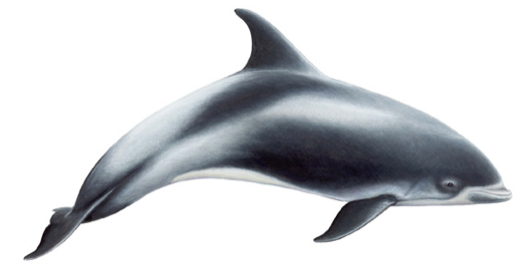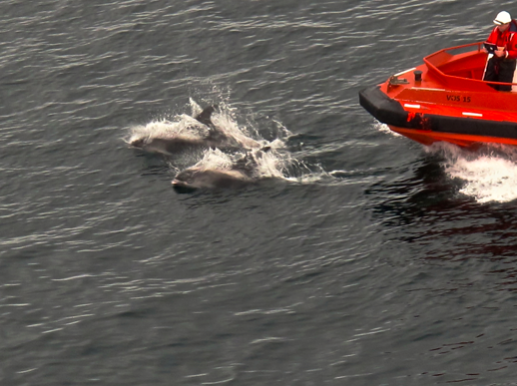It has come to our attention here at the Sea Watch Foundation that white-beaked dolphins (Lagenorhynchus albirostris) have a been a common feature on our coastlines recently!
White-beaked dolphins are short-beaked oceanic dolphins found within the family Delphinidae (also the family of the well known bottlenose dolphin, Tursiops truncatus). These dolphins get their name from their short-beak, which has a distinguishable white tip; although this may not always be the case, making identifying these dolphins a fairly difficult task! However all is not lost, as unlike their very similar looking cousins the Atlantic white-sided dolphins (Lagenorhynchus acutus) they have a white saddle patch found behind a very distinctively hooked dorsal fin, white stripes, and are slightly larger at 3.1m in length (Figure 1).
Figure 1. White-beaked dolphin schematic, demonstrating characteristic short-beak with white tip, white stripes and white saddle patch behind a distinctive hooked dorsal fin.
Although white-beaked dolphins can be seen around the UK, as they inhabit North Atlantic temperate to subpolar waters, they are more regularly spotted offshore in the Southern North Sea. However, from April this year we at Sea Watch have received a number of unusual and exciting sightings from coastal areas spanning from Devon on the South coast all the way to Caithness at the top of Scotland (see table 1)! These sightings also included an unusual sighting near Southwold in Suffolk (see our previous blog).
Table 1. Sighting location, number of white-beaked dolphins spotted, and the observer.
Along with letting us know about their encounters, a number of observers also provided us with some fantastic photographs; incredibly useful pieces of information when it comes to verifying any of the sightings we receive. Below are some recent photographs taken by Ian Grainger (provided to us by Bill Smith) from Forties Echo, Aberdeen, where they spotted a pod of over 100 white-beaked dolphins while doing offshore work!
Figure 2. Two white-beaked dolphins bow riding, white-tipped beak can also be seen. Photographs taken by Ian Grainger, provided to the Sea Watch Foundation by Bill Smith (APACHE NORTH SEA).
Figure 3. Photograph helps to show the distinctive white stripes, saddle patch and hooked dorsal fin. Photographs taken by Ian Grainger, provided to the Sea Watch Foundation by Bill Smith (APACHE NORTH SEA).
Figure 4. White-beaked dolphin demonstrating its aerial acrobatics. Photographs taken by Ian Grainger, provided to the Sea Watch Foundation by Bill Smith (APACHE NORTH SEA).
With our National Whale and Dolphin Watch #NWDW2015 happening from the 25th July to 2nd August, this is a fantastic time for you to get involved and see if you can spot white-beaked dolphins for yourself!
To see if there are any events being held near you check out our Sea Watch NWDW webpage (you can even arrange a watch of your own), because who knows what you might see out there!
Written by Charlotte Findlay, Sea Watch Research Intern 2015.
*New white-beaked dolphin sightings recorded*
During the National Whale & Dolphin Watch so far, up to fiftteen white-beaked dolphins have been recorded off Northumberland on July 25th (in four seperate sightings), six off South Shields on the 26th and two off South Shields on the 27th.





























